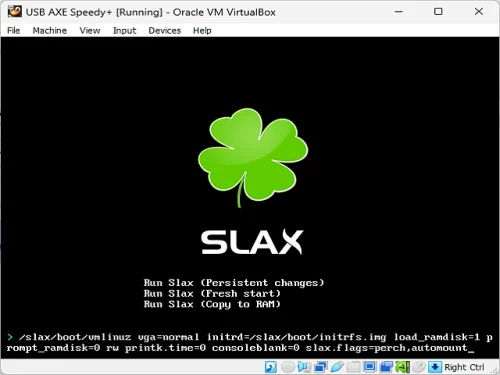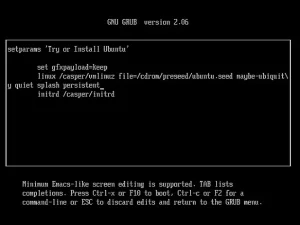SLAX Cheat codes; Booting parameters or boot codes are used to manipulate the startup booting process of Linux. Some of them are common for all Linux versions, others are specific to SLAX only. You can use cheat codes to enable or disable specific hardware detection, to start SLAX from a hard disk or other media, to skip the login prompt and start GUI, etc.
How and when to use SLAX Cheat Codes

Start to boot your computer waiting until the SLAX logo appears with a boot menu. Select your entry and hit Tab key, enabling you to edit the command string. Add any of the following boot code arguments to the end of command string.
SLAX Cheat Codes | Boot Parameters and their functions
| SLAX Boot Parameter | Function Description |
|---|---|
| acpi=off | Disables ACPI (Advanced Configuration and Power Interface) functionality. |
| nohotplug | Prevents hot-plugging of hardware devices. |
| nopcmcia | Disables PCMCIA (Personal Computer Memory Card International Association) support. |
| noagp | Disables specified hardware autodetection, requiring manual module loading. |
| nodma | Disables DMA (Direct Memory Access) for CD-ROMs and disks. |
| nohd | Prevents mounting of any hard disks. |
| nocd | Prevents mounting of any CD-ROMs. |
| nosound | Mutes sound instead of raising volume to 77%. |
| from=/dev/hda1/slax.iso | Specifies the source location for SLAX ISO file, e.g., loading from a specific device. |
| from=path/to/slax.iso | Loading the ISO from a specific path. |
| from=path/to/slax/ | Load SLAX data from different place instead of the boot device. Searches through all disks for a directory 'path/to/slax' and expects the contents of unpacked ISO in there. |
| passwd=somepass | Sets the root password to "somepass". |
| passwd=ask | Prompts for a new root password during boot. |
| changes=/dev/device changes=/dev/device/file.dat changes=/path/ changes=/path/file.dat |
Stores changes made in SLAX on a specified device rather than in memory. All changes you made in SLAX are kept in memory until you reboot. But with this boot parameter, you tell SLAX to use different device then memory for storing changes. You can, for example, format your disk partition /dev/hda1 with some Linux filesystem (eg. ext2) and then use changes=/dev/hda1 to store all changes to that disk. This way you won't loose your changes after reboot. |
| copy2ram | Copies SLAX files to RAM for faster performance. |
| toram | Copies all files (all required and optional modules) to RAM, requiring sufficient memory. You'll need at least as much RAM as the ISO to do this and boot SLAX properly. This will slow down the boot phase but it will speed up SLAX! |
| slax.flags=toram | Same as "toram" but specified as a flag. |
| perch | Enables SLAX persistence, saving and restoring changes on subsequent boots. |
| load=module | Loads optional modules from the /optional/ directory on the USB/ISO. |
| noload=module | Disables loading of specified modules, affecting all modules on the SLAX USB/ISO. |
| debug | Enables debug mode, allowing access to bash during boot for debugging. Press Ctrl+D to continue booting. |
| autoexec=... autoexec=xconf;startx;reboot |
Executes specified commands instead of SLAX login, separated by semicolons. In this example, skip slax login prompt and automatically start XWindow system. Use semicolon (;) as command separator. |
This concludes the usage of SLAX cheat codes or boot codes. Learn more about SLAX from the authors official site


